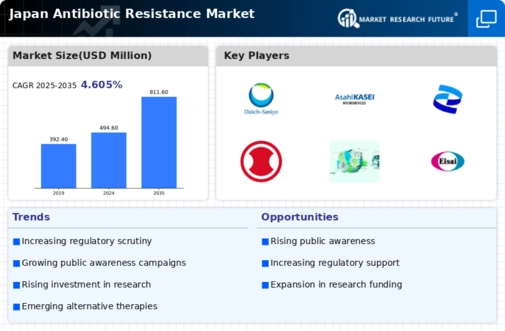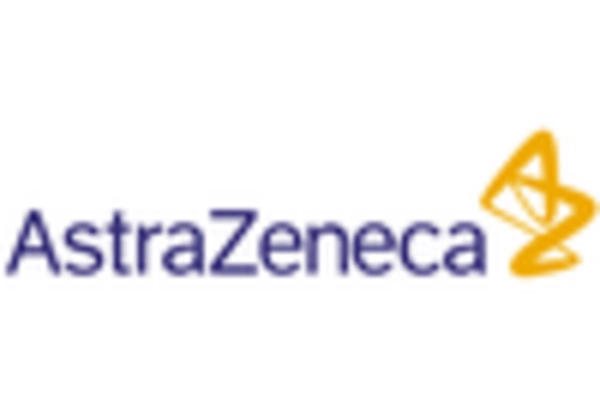Regulatory Support for New Antibiotics
Regulatory bodies in Japan are increasingly supportive of the development and approval of new antibiotics, which serves as a significant driver for the antibiotic resistance market. The Pharmaceuticals and Medical Devices Agency (PMDA) has streamlined the approval process for novel antibiotics, aiming to encourage innovation in this critical area. This regulatory environment is conducive to the entry of new players into the market, potentially leading to a wider array of treatment options for resistant infections. Furthermore, the Japanese government has introduced incentives for pharmaceutical companies, including financial support and expedited review processes, which could enhance the market landscape. As a result, the antibiotic resistance market may experience a surge in new product launches, addressing the urgent need for effective therapies against resistant bacteria.
Rising Incidence of Resistant Infections
The rising incidence of antibiotic-resistant infections in Japan is a pressing concern that drives the antibiotic resistance market. Reports indicate that approximately 30% of bacterial infections in hospitals are resistant to commonly used antibiotics, leading to increased morbidity and healthcare costs. This alarming trend has prompted healthcare providers to seek alternative treatment options, thereby boosting demand for innovative therapies and diagnostics. The economic burden associated with resistant infections is substantial, with estimates suggesting that the annual cost to the Japanese healthcare system could exceed ¥1 trillion. Consequently, stakeholders in the antibiotic resistance market are likely to focus on developing effective solutions to combat this growing threat, which may include novel antibiotics, combination therapies, and advanced diagnostic tools.
Growing Awareness of Antibiotic Resistance
The increasing awareness of antibiotic resistance among healthcare professionals and the general public in Japan is a crucial driver for the antibiotic resistance market. Educational campaigns and initiatives by health organizations have highlighted the dangers of misuse and overuse of antibiotics. This heightened awareness is likely to lead to more prudent prescribing practices and increased demand for alternative treatments. As a result, the market may see a shift towards innovative therapies and diagnostics aimed at combating resistant infections. The Japanese government has also recognized this issue, allocating approximately ¥10 billion to combat antibiotic resistance, which further emphasizes the importance of addressing this public health challenge. Such investments are expected to stimulate growth in the antibiotic resistance market, as stakeholders seek effective solutions to mitigate the impact of resistant pathogens.
Technological Advancements in Treatment Options
Technological advancements in treatment options are significantly influencing the antibiotic resistance market in Japan. Innovations such as bacteriophage therapy, monoclonal antibodies, and CRISPR technology are emerging as potential alternatives to traditional antibiotics. These novel approaches may offer effective solutions to combat resistant infections, thereby attracting interest from both healthcare providers and pharmaceutical companies. The Japanese government is actively promoting research in these areas, with funding initiatives aimed at fostering innovation. As a result, the antibiotic resistance market may witness a transformation, with an increasing number of companies investing in the development of cutting-edge therapies. This shift could lead to a more diverse treatment landscape, ultimately improving patient outcomes and addressing the challenges posed by antibiotic resistance.
Investment in Antimicrobial Stewardship Programs
Investment in antimicrobial stewardship programs (ASPs) is becoming increasingly prevalent in Japan, serving as a vital driver for the antibiotic resistance market. These programs aim to optimize the use of antibiotics, reduce unnecessary prescriptions, and improve patient outcomes. Hospitals and healthcare facilities are allocating resources to implement ASPs, which may include training for healthcare professionals and the establishment of guidelines for appropriate antibiotic use. The Japanese government has recognized the importance of these initiatives, providing funding and support to enhance their effectiveness. As a result, the antibiotic resistance market is likely to benefit from the increased focus on responsible antibiotic use, leading to a potential reduction in the prevalence of resistant infections and a shift towards more sustainable treatment practices.

















Leave a Comment